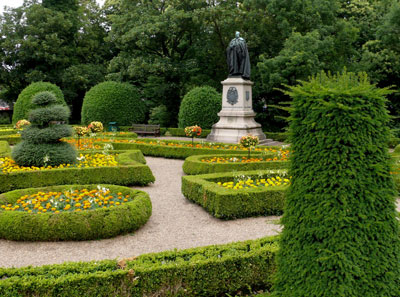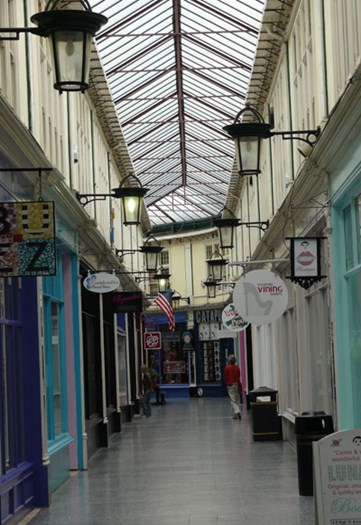CARDIFF, WALES – A small dusting of sugar that had dropped from the Welsh cakes I so exuberantly devoured settles on my black trousers and a young server offers to sweep away the sweet residue with a small brush.
My rave review of the sugar-coated, currant-filled, pancake-like discs enjoyed by the Welsh at breakfast, lunch or any time the mood strikes, is met with gratitude and a tip from the server.
“If you like these, sir, then you’ll love the ones they serve at the Fabulous Welsh Cakes Bake Shop on Mermaid Quay at Cardiff Bay. They’re the best in the city,” says the young server at the chic boutique-style Park Plaza Hotel, the city’s trendiest accommodation.
I quickly inquire the whereabouts of Cardiff Bay - the revitalized docklands that has been transformed into the city’s new entertainment zone, complete with waterside restaurants, a huge Ferris wheel and an ultra-modern performing arts palace called the Millennium Centre - and how one gets there.
“By bus, train (the Arriva train from City Centre), boat (waterbus from City Centre), or taxi, sir,” says the server.
“But the shops there won’t open for a few hours yet so you’ll have plenty of time to explore our City Centre. It’s very easy to walk – everything of interest is very close by,” says the delightful young woman in an accent as sweet as a Welsh cake topping.
Cardiff, the youngest capital city in Europe, is indeed a compact treasure filled with manicured parks, pedestrian malls, wonderful museums, great restaurants and loads of historic sites and a stunning collection of Victorian and Edwardian shopping arcades.
So, armed with a small map, my camera and some local knowledge from the Park Plaza server, we set off on a walking tour of one of the most intriguing cities in all Europe.

Top of Page: Cardiff Castle. Above: City is blessed with tranquil gardens.
It doesn’t take long to come upon the first of Cardiff’s great old buildings, the New Theatre – or Theatr Newydd, as they say in Welsh - located just a few doors down from the Park Plaza on Park Place off Greyfriars Road.
The stately playhouse has been hosting theatrical performances continuously for over 100 years – its first play, William Shakespeare’s Twelth Night, was staged in 1906 – and some of the world’s greatest entertainers – Sarah Bernhardt, Anna Pavlova, Laurel and Hardy, Shirley Bassey and Wales’ favourite son Tom Jones – have performed here.
We’re off to a good start.
Faced with the choice of turning right at Park Place and entering a pedestrian mall known as Queen Street – the main shopping area of Cardiff – or turning left and walking through lovely Gorseed Gardens, we opt for the latter because the gardens lead to some of the capital’s loveliest buildings - City Hall and the National Museum – as well as a collection of pretty parks that make up the City Centre and the neighbouring university district.
Gorseed Park is filled with lovely flower beds, distinguished statues of heroes past and its own version of Stonehenge.
Although built in 1906, the City Hall’s stately design - complete with clock tower and dragon-topped dome - makes it look much older. It sits in an area called Cathays Park and its ornate entrance is filled with marble statues of legendary Welshmen, including the nation’s patron, St. David.
Right behind City Hall is beautiful Alexandra Gardens, featuring a delightful array of rose bushes and the country’s war memorial. The park also leads to Wales’ National Assembly building and to the right of the park, off Museum Ave., sits the University of Wales’ main building, which started out as St. David’s College in 1822.
On a sunny day, this is where people like to linger; lounging on the manicured lawns under ancient trees and breathing in the sweet scents coming from the many gardens scattered about the City Centre. But rain is in the air so we rush to the entrance of the National Museum.
The museum is one of Europe’s finest and is renowned as having the best collection of Impressionist paintings (Van Gogh, Degas, Cezanne) outside Paris. But it’s the Evolution of Wales Gallery that really impresses – the natural history exhibition is packed with electronic gizmos that help visitors retrace this nation’s exciting past.
The one place in the capital where the past comes alive is Cardiff Castle, located around the corner from the City Centre – its main entrance is off Duke Street.
The castle is Wales 2,000-year-old wonder and one of the most remarkable places we’ve ever visited. It sits on a large parcel of parkland known as Blackweir, which rests beside the gently-flowing River Taff. The castle has been home to Roman soldiers, Norman conquerors, noble knights, some of Great Britain’s richest families and, most importantly, the Third Marquess of Bute.
It was the Marquess who spent a lot of his fortune turning the castle into a grand Victorian home during a massive rebuilding binge in the late 1800s which produced the highest achievement of later Victorian Gothic Revival design. The mansion’s apartments, many of which are decorated with ornate furniture and come bathed in coloured light produced by a stunning collection of stained glass windows, rivals anything Versailles has to offer.
The oak-paneled castle library, which contains priceless Welsh and English works, and the apartment known as the Arabic Room, featuring a vaulted stone ceiling decorated with gold leaf, were our favourite places inside the mansion. The other rooms are no less beautiful, though. Lavish murals, rich sculptures and paintings abound, and the stunning detail of every fireplace keeps us spellbound throughout the tour, which costs about $15 Cdn., and is worth every penny. (Most of Wales national museums are free, by the way.)


Left: Local markets feature some Welsh treats. Right: City is noted for it ancient shopping arcades.
As lovely as the Victorian apartments are, though, it’s the Roman ruins and Norman keep that really excites castle visitors.
Archeologists suggest there may have been two Roman forts on this site, the first probably built in 55AD. The Norman keep (guardhouse) that sits at the back of the walled property was built in 1091 by Robert Fitzhamon, Lord of Gloucester, and is noted as the place where legendary Robert of Normandy was imprisoned until his death in 1134.
A group of visiting Seattle school kids is most impressed with their guide’s tale of Robert’s stay in the keep and the fact that his ghost still haunts the stone structure where modern-day visitors can climb to the top where they are rewarded with a breathtaking view of the Cardiff City Centre and its wonderful collection of parks.
From my keep perch high above the castle grounds we also get a great view of the city’s modern marvel, Millennium Stadium, a 70,000-plus covered sports behemoth which hosts international rugby – the national sport of Wales – as well as major rock concerts and soccer matches. The Welsh are proud of this venue but honestly, all these mega-sports complexes are starting to look pretty much the same and quite frankly, some, like this one, stick out like a sore thumb amongst the grandeur of the city’s stately ancient architecture.
After our castle visit, we drift off into the labyrinth of streets that make up Cardiff’s vibrant shopping district. Believe it or not, tiny Cardiff – population 340,000 – is considered a shopping Mecca in Great Britain and its collection of designer boutiques rivals anything much larger cities have to offer.
The only thing better than the shops and bargains is Cardiff’s stunning collection of arcades – covered lane ways that abound in this city where rain showers sweep in off the surrounding sea almost hourly; hence the reason they were built in the first place. Queens Arcade and St. David’s Hall have been joined with the John Lewis department store to create the city’s largest arcade, but the smaller ones – Morgan, Royal, Castle, High Street and Wyndham – date back centuries and offer a great insight into the city during its Victorian era.
With all this shopping and sightseeing, we lose track of time, but my growling stomach reminds me that more Welsh cakes are required.
Remembering the server’s advice, we flag a taxi and tell the driver to take us to Cardiff Bay and Welsh cake heaven – the Fabulous Welsh Cakes Shop at No. 14 Mermaid Quay.
Just a short drive from the City Centre, Cardiff Bay is the result of a barrage project that created a large freshwater lake and a new 12-kilometre-long waterfront that was just begging to be developed.
The city didn’t disappoint and shovels were dispatched to this area, where once ships lined up to take the country’s coal to foreign lands.
The crown jewel of the Cardiff Bay project is the Wales Millennium Centre, home of the internationally renowned Welsh National Opera and a place where the cream of the entertainment world comes to perform.
The area is dotted with many small craft and souvenir shops and soon we are standing at the entrance of No. 14 – the Fabulous Welsh Cakes Shop.
A fresh batch of Welsh cakes, crammed with currents, is being baked on a small flat top grill and the lineup stretches outside the shop.
“A dozen for four pound, fifty,” a young baker chimes.
Her eyes bulge when we ask for three dozen of the sweet treats.
“I see you really like our Welsh cakes,” says the server.
One visit to Cardiff and you quickly learn the only thing sweeter than Welsh cakes is the Welsh capital itself.